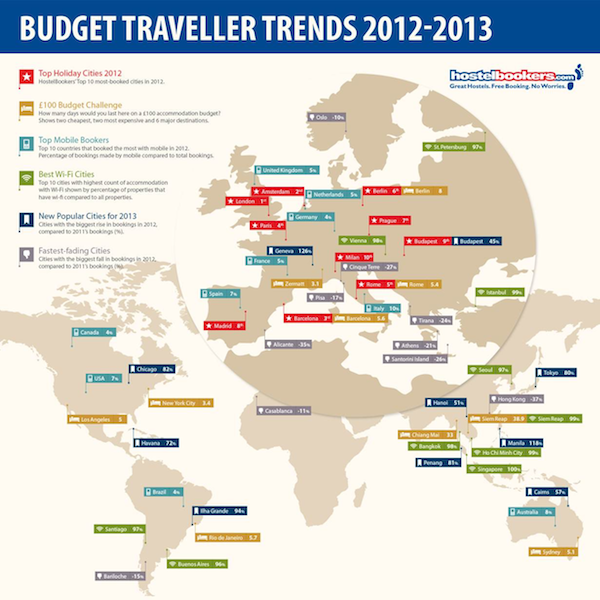

The Power of Infographics on your blog
This is a guest contribution from Chelsea Varney, a Community manager at Brandwatch.
Infographics are extremely useful for numerous reasons when it comes to content marketing and blogging.
Although many writers may not have considered using an infographic for a blog post this can be an excellent way to present interesting information while linking to a topic that is of significance to yourself and your readers.
What an infographic offers is easily digestible data which is presented in a pleasing form to an audience. The genius of an infographic is that it can communicate multiple facts or stats in a quick format.
A reader may not have time to peruse a whole blog on the rise of digital technologies or stats on WordPress users but a quick synopsis of a useful infographic may be of interest to them.
Unsurprisingly, using an infographic for a post can draw attention to a blogging site due to its shareability.
Unlike some images used within blog posts, an infographic can give an overall summary of a blog which will entice readers into looking at their article in more depth.
It has been proven that visuality is an essential element in the sharing of posts on social media.
Take Twitter as an example, tweets with images received 150% more retweets than those who did not have them, 18% more click throughs and 89% more favourites by fellow users. These are substantial figures when you are trying to get people to share your hard work with others.
Find an Interesting Infographic
When you find an interesting and informative infographic that grabs your attention while teaching you some new facts, you know that you are on to a winner! However, there are some points that you must consider when choosing an image to use on your site.
Although a blog which uses an infographic may be a success, it could also isolate an established audience if it is not relevant to their topic of interest. Do not use an infographic on cooking if your other articles are on digital technologies.
2. When choosing an infographic, take a look at the date that it was released. Old facts and stats are not going to interest your readers as much as those that were created this year.
Also, competing blogs may have already used this as a topic for a previous post. Being up to date on this will put you ahead of other bloggers.
3. Make sure that you read the whole infographic before dedicating your time writing a post on it. The infographic may only possess a few pieces of information that are relevant to you.
This will not be enough to support an entire blog post dedicated to the infographic. Instead you could use it as a supporting piece for another topic.
4. Some people may wonder how you measure the quality of the infographic? Unfortunately, there are some poorly executed graphics that are circulating the internet which demonstrate what you do not want to place in your blog.
Poor research, over generalisation and ineffective imagery leads to a picture which does not capture the imagination of the audience.
For instance, take a look at this infographic which is on gender division in the workplace. It does not deliver on its promise of explaining the difference of gender in the workplace instead it simply states some opinions with no objective evidence. To be honest, it’s pretty pointless. 
An infographic which is clear in its objectives and delivers them in a fun and informative way will certainly grab the attention. However, some of you may be wondering how you will create an entire blog post around one image.
Here are some tips to writing about infographics:
Take this infographic on the trends of budget travellers in 2012-2013:
 It is a relatively modern image that is simple yet offers some interesting figures on global cities, traveling needs and wants. Using information from their website they have calculated emerging cities and those which have fallen in popularity since their previous survey.
It is a relatively modern image that is simple yet offers some interesting figures on global cities, traveling needs and wants. Using information from their website they have calculated emerging cities and those which have fallen in popularity since their previous survey.
Firstly, to write a blog about this infographic you would need to outline the topic area that is being addressed. You need to introduce your audience to what the blog will be about and why they should be interested. How could this affect them?
For instance, you could discuss why travel is important for both the cultural and economic development of society. You will need to conduct some more research into the area and to not simply rely on the infographic alone.
Discuss the key findings of the infographic and its implications. Tokyo is emerging as a new tourist area for 2013 according to the hostelbookers survey. Could this mean that people are traveling further afield for holidays.
Go through each stat on the infographic and pick out which fact is most useful to you. The whole image does not need to be discussed in a blog only the key points.
Including a conclusion to what the infographic has taught you will also provide a strong ending to a blog and could encourage comments from others who agree with you (or even those who have a different view).
In the travellers image we can see that Europe is where all the most popular cities are for budget travellers according to Hostel Bookers an interesting fact that a reader may not have been aware of.
An infographic can also be used purely to support a topic that you have a knowledge of. Simply by using an image that is easy to share, you can increase the amount of people heading over to view your blog.
Another added benefit of using an infographic as the basis of your blog is that quite a bit of the content is already prepackaged for you. The infographic is providing you with a lot of data that you can use without much need for researching.
There is a whole host of reasons for using infographics but, as always, the most important is the increase of followers to your blog through presenting interesting content. Why not give it a try?
Chelsea Varney is a Community manager at Brandwatch , a social media monitoring company. You can connect with Chelsea onTwitter or Linkedin.
Originally at: Blog Tips at ProBlogger
Facebook comments:
No Comments »
No comments yet.
RSS feed for comments on this post. TrackBack URL
Leave a comment















